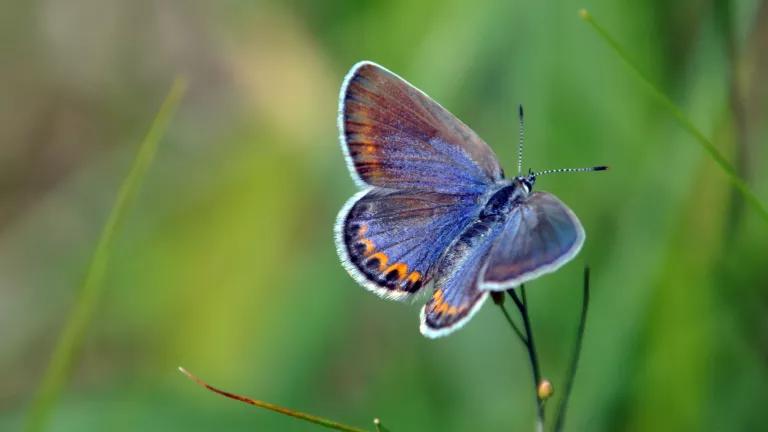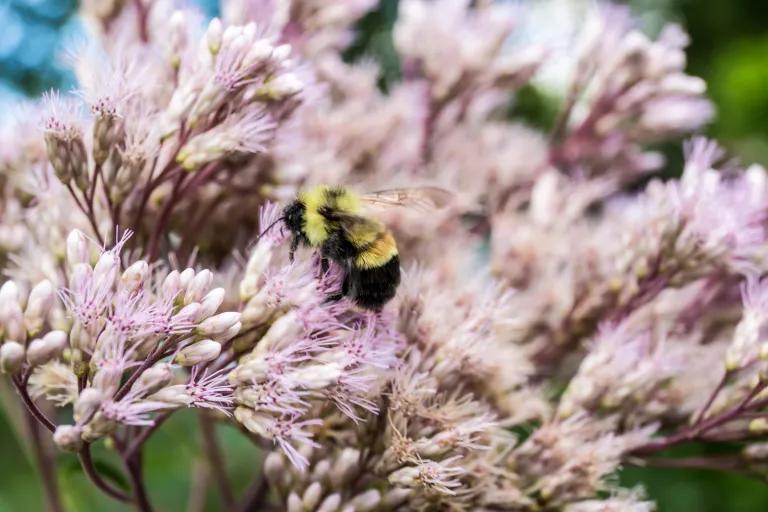UPDATED: EPA Can't Ignore Neonics’ Impacts on Imperiled Species
NRDC and the U.S. Environmental Protection Agency have entered into a settlement agreement requiring EPA to evaluate the impacts of bee-killing neonicotinoid insecticides on species listed as threatened or endangered.

An endangered Karner blue butterfly
UPDATE: Following NRDC’s lawsuit, EPA agreed to issue “effects determinations” for two commonly used neonic insecticides, acetamiprid and dinotefuran, by October 2024. EPA has now issued two draft determinations that confirm these neurotoxins’ widespread harm to wildlife and underscore the need to eliminate unnecessary uses of the chemicals.
EPA found that dinotefuran and acetamiprid likely harm 1,259 and 1,005 threatened and endangered species, respectively. In other words, dinotefuran is likely to harm nearly 75% of imperiled species, and acetamiprid likely harms over half. Worse still, the agency predicts that their continued use is likely to push about 10% of listed species toward extinction, in line with estimates for other neonics. Finalizing these determinations is the next step in a long process that is likely to result in additional restrictions to protect these precious species. But EPA—and states—should not wait for that process to play out before protecting people, pollinators, and other wildlife from the ecological destruction caused by neonics.
Harmful pesticides, called neonicotinoids or “neonics,” have been wreaking havoc on bees and other important pollinators for decades. Finally, after nearly four years of litigation, the U.S. Environmental Protection Agency (EPA) has committed to assessing the impacts of three neonics on threatened and endangered species across the country. EPA made these commitments in a pair of legal settlements between the agency and the NRDC. Depending on the results of EPA’s assessments (which, under the settlement agreements, are due in 2022 and 2024), EPA ultimately may be required to impose restrictions on the use of these harmful pesticides.
In 2017, NRDC sued EPA after it approved dozens of neonic pesticides without complying with the Endangered Species Act (ESA). The Act requires EPA to ensure that pesticides registered by the agency are not likely to jeopardize threatened and endangered species. If the pesticide may affect such species, EPA must engage with the U.S. Fish and Wildlife Service and National Marine Fisheries Service in a process referred to as “consultation.” This consultation must be completed before EPA registers the pesticide at issue. But for decades, EPA has given the green light to pesticide products, including neonics, without consultation.

Endangered bees and butterflies are just some of the many wild pollinators that suffer from neonic use. Declining pollinator populations put the future of our food supply at risk.
Since their introduction in the 1990s, neonics have been identified as a leading cause of catastrophic bee declines. These toxic pesticides have also been linked to declines in birds and the hollowing out of aquatic ecosystems. Despite these vast environmental harms, EPA has continued to allow widespread use of neonics. In fact, neonics are now the most widely used insecticides in the country, covering over 150 million acres nationwide. Chances are, you’ve come into contact with neonics—either on your food or during a home pest treatment—whether you know it or not. Center for Disease Control (CDC) data shows that half of Americans are exposed to neonics on any given day.
After overcoming EPA’s attempt to throw our case out of court, NRDC and the EPA reached a partial settlement in January 2021. That agreement requires the agency to begin consultation on imidacloprid, one of the most commonly used neonics, by June 30, 2022.
EPA kicked off that process this year by releasing a proposed “effects determination” in August, finding that a staggering 1,445 species—just short of 80% of all endangered and threatened species in the U.S.—are likely harmed by use of imidacloprid.
Side Note: As the result of a separate lawsuit by the Center for Food Safety, EPA has released the same proposed “effects determinations” for two other neonic chemicals—clothianidin and thiamethoxam--and found likely harm to 1,225 and 1,396 species, respectively.

Neonics contaminate the environment so broadly that they have cascading, ecosystem-wide impacts. So though pollinators are most directly impacts, far more species feel their effects.
NRDC and EPA have now settled the remaining claims in NRDC’s lawsuit. This latest settlement requires EPA to evaluate the effects of two major neonics—acetamiprid and dinotefuran—on endangered and threatened species by October 2024. If EPA determines that acetamiprid and dinotefuran are likely to harm endangered or threatened species, the settlement requires EPA to begin the formal consultation process required under the ESA.
Getting EPA to begin the consultation process for neonic pesticides could lead to big changes. The ESA gives wildlife—specifically, endangered and threatened species—the absolute highest of priorities. And given EPA’s initial determinations that certain neonics are likely to harm thousands of species, there’s a good chance the consultation process could result in significant, meaningful restrictions on use of neonics to avoid jeopardizing those species. Our team will continue to monitor EPA’s process to ensure that it follows the law, so check back for updates.




